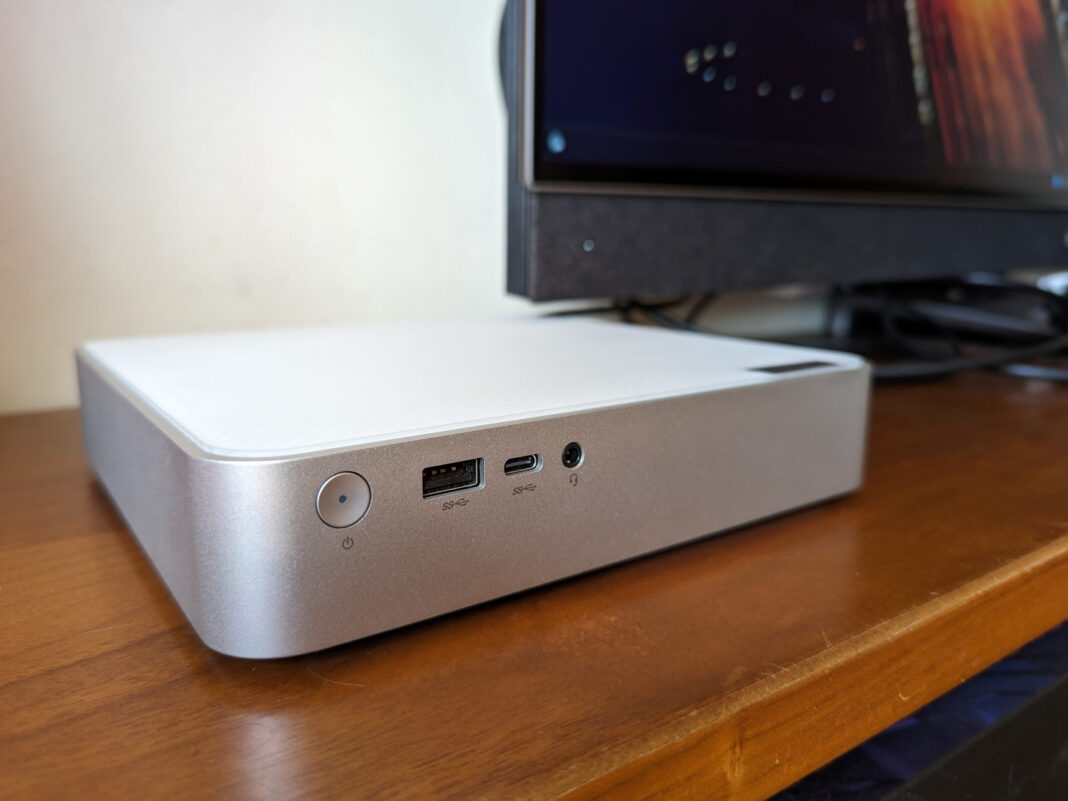Lenovo offers several Think-branded mini PCs ranging from the ThinkCentre to the ThinkStation all aimed at offices and professional environments. To contrast these business-centric models, Lenovo has made available this year the consumer-centric 1 liter IdeaCentre Mini Gen 8 complete with the latest Intel 13th gen Raptor Lake-H CPUs to complement the larger IdeaCentre 5i. Our review unit is the higher-end configuration with the Core i7-13700H for approximately $688 USD while the lower-end Core i5-13500H option starts at just $522.
All SKUs ship with 16 GB of RAM, 512 GB to 1 TB of storage, and Windows 11 meaning there are no barebone options. The IdeaCentre Mini competes with other small mini PCs with integrated graphics such as most Intel NUC models , Beelink GTR7 , Geekom Mini IT11 , or Trigkey Speed S . More Lenovo reviews: The IdeaCentre may not be a ThinkCentre, but it’s almost built like one.
The metal sides, internal rollcage, and integrated PSU contribute to a dense mini PC especially for a consumer product. Pushing down on the center of the outer lid results in almost no warping, though a bit of creaking is audible. The unit can be positioned vertically such as on a bookshelf without blocking any vents.
A notable omission, however, is support for VESA mounting likely due to how heavy the unit is. Many consumer mini PCs like those from Beelink and even some office-centric ones can be mounted behind monitors to save on desk space. The IdeaCentre Mini is much larger and heavier than many other mini PCs with no discrete GPUs.
The Intel NUC 13 Pro, for example, is almost 3x lighter and has a much smaller footprint. Instead, the key advantage of the IdeaCentre Mini is its fully integrated PSU which trades away the annoyances of an unsightly power brick commonly found with most mini PCs and laptops in favor of a larger but more convenient chassis. We personally prefer the advantages of an integrated PSU as it means there is no proprietary power brick to accidentally lose.
Port options are excellent especially since the model integrates full-size DisplayPort, 2. 5 Gbps RJ-45, and multiple USB-C ports for a total of three different video-out options. Note that only the rear USB-C port supports video as the front USB-C port is for data and charging only.
There is no Kensington Lock port as the IdeaCentre Mini is designed for homes and not public office spaces. The model ships with a Realtek RTL8852BE for Wi-Fi 6 and Bluetooth 5. 1 connectivity.
It does not include Wi-Fi 6E to save on costs which is a bit of a shame as Wi-Fi 6E is most beneficial for HTPC game streaming purposes. Performance is nevertheless steady and reliable when paired to our Asus AXE11000 test router. Servicing requires a bit more work than an Intel NUC or Beelink GTR/GTI series due to the integrated PSU.
To begin, users must first remove the top cover of the unit by pushing a button near the rear HDMI port. Once the top panel is off, users must then remove four Phillips screws that hold the bottom panel in place. Next, two more buttons must be pushed in order to remove the bottom cover of the chassis to expose the fan and integrated PSU.
To access the 2x SODIMM slots, 2x M. 2 SSD slots and WLAN module, however, the fan and PSU must be removed as shown by the images below. This part is thankfully quite simple as the fan and PSU are secured by latches and not screws.
Thankfully, the online Lenovo manual here details the disassembly. The standard retail box includes the paperwork, standardized 2-prong AC power cord, and a removable vertical stand. The usual one-year limited manufacturer warranty applies.
We set the system to its default “Lenovo Balanced” mode prior to running the benchmarks below. There is no specific Performance mode via Windows or the Lenovo Vantage software. Users should still become familiar with Vantage nonetheless as it is the hub for Lenovo-specific updates and security settings.
CPU performance is in line with the average PC in our database equipped with the same Core i7-13700H if not slightly lower by a few percentage points due to the limited Turbo Boost of the Lenovo mini PC. When running CineBench R15 xT in a loop, for example, the initial score of 2240 points would drop by 16 percent over time whereas the 14-inch Acer Predator Triton can maintain faster clock rates over time with the same processor. Even so, the IdeaCentre Mini is still faster than most other mini PCs running on older 12th gen Core-H or AMD Zen 3+ CPUs.
Users would have to consider mini PCs with Zen 4 options like the Beelink GTR7 or other Core-HX options for something appreciably faster than our Lenovo. Downgrading to the Core i5-13500H configuration is expected to entail a performance deficit of up to 10 percent based on our time with the Minisforum Venus Series NPB5 . PCMark scores are higher than many other mini PCs powered by 12th gen Intel CPUs or Core-P series CPUs like the Intel NUC 13 Pro or Beelink GTi11 .
Mini PCs with newer AMD CPUs like the Beelink GTR7 can handily outperform our Lenovo in the Productivity and Digital Content Creation subtests due to the slower multi-thread CPU performance and graphics performance of our IdeaCentre Mini. LatencyMon reveals DPC issues when opening multiple browser tabs of our homepage. Additionally, we’re able to record 2 dropped frames during a 60-second playback of a 4K video at 60 FPS.
Though 2 frames is hardly noticeable, 0 dropped frames is ideal and more common on other PCs. The system ships with a Samsung PM9B1 PCIe4 x4 NVMe SSD which is the budget version of the faster Samsung PM9A1 commonly found on higher-end mini PCs or gaming laptops. Maximum transfer rates are steady and sustainable at 3600 MB/s compared to 5500 MB/s on the Intel NUC 13 Pro sporting the Samsung PM9A1.
The PM9B1 is nonetheless more than sufficient for consumer multimedia purposes and it balances well with the Core i7-13700H. Up to two PCIe4 x4 2280 SSDs can be installed. The integrated Iris Xe 96 EUs is starting to show its age when compared to the latest options from AMD.
The Radeon 680M , for example, can be up to 50 to 60 percent faster and the newer Radeon 780M is even faster still. Nonetheless, performance is reliable for non-gaming applications such as 4K playback and streaming. For gaming purposes, it’s recommended to attach an eGPU or opt for another mini PC equipped with more powerful AMD Radeon 780M graphics instead like the Beelink GTR7 or Minisforum Venus Series UM790 Pro .
If not, the Iris Xe 96 EUs is only powerful enough for cloud streaming or running local games on very low settings and resolutions save for undemanding ones like DOTA 2 Reborn . The internal fans are always active no matter the loud at about 30 dB(A) against a silent background of 24 dB(A). This is loud enough to be an audible hum in a very quiet room, but it’s thankfully not loud enough to be distracting when gaming or watching movies.
The fans also rarely pulse to higher RPMs when running low to low-medium loads and so the 30 dB(A) floor is fairly constant. We’re able to record a maximum fan noise of 41 dB(A) when running more demanding loads like games or Prime95 for extended periods which is comparable to the Beelink GTR7 or NUC 13 Pro under similar conditions. The hot spot on top of the unit can reach 40 C when running demanding loads for long periods which is much warmer than what we recorded on the Beelink GTR7 by almost 12 degrees.
The generally higher surface temperatures may be due to two factors: the integrated PSU and lack of upper ventilation grilles which contribute to higher temperatures overall. Cool air instead enters from the bottom of the unit unlike on most other mini PCs. When running Prime95 to stress the CPU, clock rates and package power draw would spike to 3.
3 GHz and 80 W, respectively, lasting for only a couple of minutes at a core temperature of 95 C. Thereafter, clock rates and package power draw would drop to around 2. 5 GHz and 44 W in order to maintain a cooler core temperature of 81 C.
High Turbo Boost is thus not sustainable for long periods which is in line with what we observed during our CineBench R15 loop test above. Repeating the above Prime95 test on the Ryzen 7 7840HS-powered Beelink GTR7 and Core i5-1235U-powered Beelink SEi12 would result in cooler core temperatures of 76 C and 67 C, respectively, even though the IdeaCentre Mini is much larger and heavier. The Lenovo mini PC is quite power-hungry even when compared to full-fledged laptops with the same Core i7-13700H CPU.
The Schenker Vision 16 , for example, demands 15 percent less power when running Witcher 3 . The Intel NUC 13 Pro and Beelink SEi12 are also more power efficient, but they come with slower Core-P and Core-U CPUs, respectively. We’re able to record a temporary maximum draw of 105 W when the CPU is at 100 percent utilization.
This rate would quickly fall since Turbo Boost potential is limited as mentioned in the Stress Test section above. It’s worth noting that while the model doesn’t need an external power brick, the included power cable is nonetheless very short at just over 3 feet long. Main reasons for choosing the IdeaCentre Mini over other mini PCs are for its integrated PSU and fast Core H-series CPU.
If you like to run CPU-intensive tasks and hate dealing with power bricks, then this Lenovo solution will be considerably faster than the sea of smaller alternatives running on Core U CPUs. The most notable drawback to the IdeaCentre Mini is that it’s big and heavy relative to the performance you’re getting. Smaller and lighter alternatives like the Geekom Mini iiT13 or Beelink SER7 come with the exact same processor or comparable AMD options while still offering upgradeable RAM and storage.
The lack of VESA mounting also limits where you can position the Lenovo mini PC. Of course, if you plan on placing the unit flat on a home desk or table anyway, then the heavy weight, large footprint, and lack of VESA mounting or Kenginton lock likely aren’t going to be deal breakers. The IdeaCentre Mini is sturdier than it looks and it has the Core H performance for when higher processing power is needed.
There are a couple of minor annoyances, but they are relatively easy to overcome. A minor inconvenience worth mentioning is the 3-foot power cord which is one of the shortest cords we’ve seen on any laptop or mini PC. When considering that most desks are about 30 inches from the floor, the system must essentially be placed directly above a power outlet or else its power cord won’t reach.
You might need to invest in a longer cord depending on your setup. For future models, we’d love to see Wi-Fi 6E, faster RAM, and tool-free servicing to maximize game streaming potential and make upgrades a bit easier. Its current price of under $700 USD is competitive against other mini PCs especially since the Lenovo solution includes Windows 11, RAM, storage, and a Core H-series CPU instead of slower Core U or Core P.
Lenovo is now shipping its IdeaCentre Mini Gen 8 for $688 USD for the Core i7 configuration as reviewed or just $560 for the base Core i5 option. Alternatively, Best Buy is also shipping the Core i7 option for a higher price of $850. .
From: notebookcheck
URL: https://www.notebookcheck.net/Lenovo-IdeaCentre-Mini-01IRH8-review-An-Intel-NUC-challenger-approaches.743889.0.html



